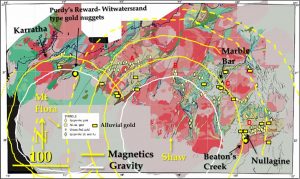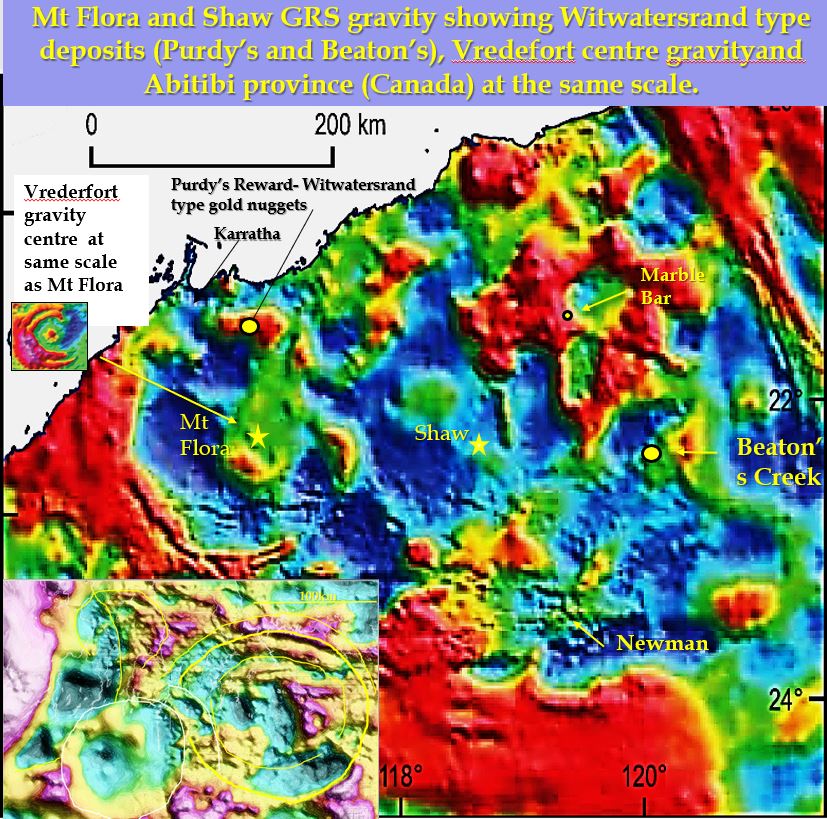Witwatersrand style gold targets? Shaw 220km diameter Giant Ring Structure discovered in East Pilbara Craton, Australia. Oldest Archaean Impact Structure?

Witwatersrand style gold!
This paper is the first in a series that will document the Shaw giant ring structure (GRS) in the East Pilbara Craton as observed in geoscientific data.
The Shaw giant ring structure centre is located at 22˚ 10’S and 118˚55’E, about 200km south of Port Hedland and 150km NNW of Newman near Shaw siding in the Chichester Ranges. These papers record empirical observations and are published as a springboard to advance research and exploration of the East Pilbara. Speculation on a possible impact origin and exploration potential of the Shaw GRS is developed during the paper.
The concentric nature and the morphology of these rings suggest that the Shaw GRS may be an impact structure. The age of the Shaw GRS is older than the base of the Fortescue basin and is possibly the cause and therefore the age of the older spherulite beds (3.47 Ga) in the East Pilbara.
Shaw GRS was discovered in 2013 when ring structures in the Pilbara were being investigated using the gravity, magnetics and radiometrics images seen in the Blewett et al. 2012 Australia in Time and Space publication.
This research was dusted off because there is recent discussion on the similarity of the West Pilbara to the Witwatersrand goldfield in South Africa and the exploration potential sparked by the discovery of many Witwatersrand type nuggets at Purdy’s Reward and Beaton’s Creek. Witwatersrand basin was formed by the Vredefort impact structure at 2.08 Ga. That there were algal mats present in the Pilbara to precipitate the gold has been well documented.
Witwatersrand Pilbara correlation.
This paper presents evidence for a giant ring structure (GRS) of the same size but older than Vredefort to create a Witwatersrand type sedimentary basin, the East Pilbara Fortescue Basin, into which the source gold was deposited. Gold mineralisation at Beaton’s Creek (Novo Resources) is associated with the intersection of the Shaw outer ring’s contact with the Mosquito Creek greenstone belt (see above image). This basal contact is marked by a conglomerate in which the gold is deposited.
Purdy’s Reward gold mineralisation lies on the Shaw 200km diameter outer ring, which marks the contact of the basal unit of the Fortescue basin with the underlying East Pilbara Craton greenstones.
There is a perfect correlation between the rings and the Witwatersrand type Purdy’s Reward and Beaton’s Creek gold projects which strengthens the Witwatersrand model for these deposits. Marble Bar and Nullagine also have conglomerate hosted gold deposits and lie exactly on the rings. Thus, exploring around these rings, especially where it intersects gold bearing greenstone/granite belts, for the best deposits is an excellent exploration targeting tool.
There are other mineral exploration opportunities where these rings intersect mineralised zones. Preliminary targeting for Witwatersrand type uranium and a refining of Pilbara iron targeting is presented.
Abitibi sub-Province (Canada) and Pilbara giant ring structure comparison.
There is evidence of giant ring structures in the Canadian Abitibi Sub-Province (yellow circles in top image) of a similar size and age to those outlined in the Pilbara.
To spread the Witwatersrand style Pilbara gold targeting update share this paper and site with your colleagues!
To see more detailed research and another 18 relevant figures click the following link —–
| a PS #1 Shaw GRS introduction paper.pdf | 3 MB |

